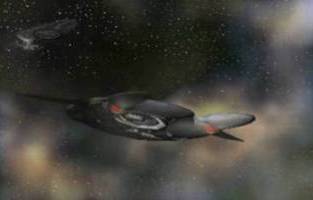
| Type | Attached Planetary Landing/Atmospheric Excursion Vehicle |
| Unit Run | The Remoras (test craft) The Freedom - assigned to USS Liberty (NX-90550) |
| Commissioned | 2376 - present |
| Dimensions | Length : 100 m Beam : 30 m (Retractable Atmospheric fins give it a 60 m wingspan) Height : 16 m Decks : 3 |
| Mass | 60,000 tons |
| Crew | 10; Capable of transporting 220 in emergency situations |
| Armament | 2 x Type XI Phaser Arrays 2 x Type U Phaser Cannon 1 x Pulse Fire Torpedo Launcher + 100 Quantum Torpedoes |
| Defence Systems | Auto-modulated Regenerative Metaphasic
shields, total capacity 2,350,000 TeraJoules Lightweight Duranium/Titanium composite hull plus 20 cm Ablative armour. High level Structural Integrity and Inertial Dampening Fields |
| Warp Speeds (TNG Scale) | Normal Cruise : Warp Factor 6 Maximum Cruise : Warp Factor 7.5 Maximum Rated : Warp Factor 8.89 for twelve hours |
| Strength Indices (Galaxy class = 1,000) | Beam Firepower : 1,100 Torpedo Firepower : 500 Weapon Range and Accuracy : 815 Shield Strength : 900 Hull Armour : 1000 Speed : 750 Combat Maneuverability : 35,000 |
| Overall Strength Index | 724 |
| Diplomatic Capability | Grade 1 (None) |
| Expected Hull Life | 20 years |
| Refit Cycle | Minor : 6 months Standard : 1 year Major : 5 years |
Remoras are specifically designed to provide what many larger vessels are incapable of, that is, to make planetary landings. The Type-I Remoras was constructed with the Tiberius-class refit in mind and connects via locking clamps to the underside of the saucer section at the fore of the ship. The Remoras craft is designed to fill a multi-purpose role, but is outfitted primarily to handle the need to have an atmospheric-capable support craft that could handle long-term engagements that would warrant its use rather than the use of a Runabout or other shuttlecraft. The Remoras craft comes out to be nearly the size of the Defiant class, though its constuction has rendered it somewhat smaller and lighter and more equipped to handle the strains faced with atmospheric flight, while also ensuring its role can be filled just as well in orbit or at warp-speed.
The Helm and Operations Cabin is located in a recession between the two sections and is protected in all sides, with an elongated viewport at the front for visual-aided piloting. Aside from helm and the command chair, there are four specialist workstations and seating for eight. To the rear there is access to the airlock which leads to the upper Entrance Hatch (when docked with another ship or for external operations when in space). A corridor also leads into the Split Cargo/Shuttlebay. Above is the Systems Core, a stripped down version of the Computer Core on the Tiberius-class. It is not equipped with an Active Computer System.
The computer system can handle most flight operations via autopilots, and an Emergency Return Beacon can allow the computer complete control of the ship for an immediate return to her mother ship in the case of an incapacitated crew. In the event that the mother ship cannot be located with the emergency beacon, the Remoras will change course and head for the nearest Starbase or Starship. Only in this emergency aspect can the Remoras computer system be considered "Active".
In order to give the Remoras better flight-control, anti-gravity sustainers, tied into the inertial dampening grid can be initialized to combat the effects of gravity. The anit-gravity sustainer modules that line the hull, at full power, can reduce the vehicle's weight by 50% on a planet ehibiting a 1G environment. The decreased weight offers a much smoother ride when piloting amongst clouds. Atmospheric flight is possible without the antigrav sustainers, but with a much bumpier ride. High-powered structual integrity and inertial dampening fields also reduce the effects of atmospheric maneuvering, offering the best in flight control and maneuverability. Also, the Remoras is outfitted with retractable Atmospheric Fins, which are deployed as necessary to aid in gliding and other flight manuevers.
The Remoras is also outfitted with Quad Landing Struts for maneuvering and setting down. Once on the ground, access is provided by the Deployment Hatch, a large ramp for personnel and cargo. The Split Cargo/Shuttlebay is outfitted with antigrav units, transporter pad, and various secure storage sections. Room for two Type-10 Shuttlepods is provided and personnel can be seated at the front wall of the bay during turbulant landings.
The primary impulse system consist of two pairs of redundant fusion reactors, space-time driver coils, and vectored exhaust directors. The exhaust products may be held temporarily in the impulse nozzle cowling, to minimize the ship's ion or EM signature.
The RCS thrusters are adapted from thruster packages from Galaxy and Ambassador class vessels. A total of eight thruster groups are installed; two are placed in the forward hull, four in the mid-hull, and two in the aft cowling. Deuterium is supplied from the primary tankage and immediate-use tanks within the thruster packages. Thruster control can be tied directly into a manual control stick for special maneuvers not handled by the computer-controlled autopilots.
Warp power is provided by two micronised cores built into the sections port and starboard of the crew area. In addition these sections contain a Warp Engine, an Impulse Engine, and fuel storage. Further forward are the Bussard Collectors.
One of the Remoras's specialized features is included in its attached state. All systems aboard the Remoras craft can be tied directly into her mother ship's systems, acting as an extra supply of weaponry as well as a back-up warp core. In the event that the Remoras twin warp cores need to be used to provide power to her mother ship, the greatest amount of power she can deliver to such a large craft is equivalent to ship-wide auxillary power, and a maximum warp speed of factor 3.